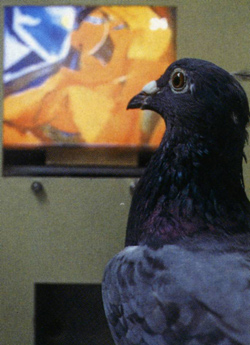This is about one of those laboratory experiments that just beg for word play in the article title. I resist. Perhaps it helps to be months removed from the publication date of the latest results; the bookmark would have been long since forgotten, except that I boldly left it at the top level of my bookmarks, where it reminded me daily of how much further behind I was falling.
Shigeru Watanabe has shown that pigeons can be taught not only to tell Monet from Picasso (PDF), but also to make seemingly more elusive distinctions, such as “good” art from “bad”. As reported in Science Daily:
In the first series of experiments, four pigeons were trained to recognize ‘good’ paintings by being rewarded with food if they pecked at the ‘good’ pictures. Pecking at ‘bad’ pictures was not rewarded. They were then presented with a mixture of new and old ‘good’ and ‘bad’ paintings and the researchers noted which paintings they pecked at. Pigeons consistently pecked at the ‘good’ paintings more often than at the ‘bad’ paintings. …presented with grayscale paintings, they were no longer able to distinguish between the paintings, indicating that they use color cues for discrimination. When the paintings were processed into mosaics, the pigeons also found it difficult to distinguish between the paintings, showing that they also use pattern cues to make their beauty judgments.
 Morgan Meis, tongue in cheek, suggests this may be the end for the few art critics left. The one consolation is that the birds seem to take no particular joy in their ability, quite contrary to the human’s tendency toward inflated pride in their refined judgment.
Morgan Meis, tongue in cheek, suggests this may be the end for the few art critics left. The one consolation is that the birds seem to take no particular joy in their ability, quite contrary to the human’s tendency toward inflated pride in their refined judgment.
Of course, the pigeons are “merely” learning what they are taught. The quotes are to indicate that this learning involves a rather high degree of abstraction from the training stimuli. One can’t help wondering whether they have any innate personal (?) preferences. On the other hand, are humans any more sophisticated in coming to their concept of beauty, the good? And besides, how much did your art education cost? More than a few weeks’ worth of birdseed, I suspect.

I remember well my art history classes. All those yummy treats I got for picking the good paintings!
But I preferred the mazes as there was always a good chunk of cheese waiting for me at the end.
Pigeons get confused when a Matisse is rotated while they can still recognize a rotated Picasso! They survive because they understand how the world and its beings are constructed – just like us.
Presumably, a Clyfford Still would program his/her pigeons to peck at paintings in which the images are unclear and not discernable.
Threatened art critics might hasten to point out that the pigeons are quite unable to argue for the superiority of their “favorites.” But Guardian critic Jonathan Jones points out that liking is fundamental, and precedes analysis even in humans.
Steve:
I,too, would take no particular joy in my ability to discriminate if I were fed the likes of Demoiselles d’Avignon. The pigeon appears to be looking askance, no?
How does the pigeon react to a photo-realist rendering of a nice New York sidewalk snack, or of an old lady sitting on a park bench holding a bag of popcorn?
Jay, would they think they’ve entered the matrix?
Jay,
It seems likely that any such painting might be at physical risk of being pecked.
There’s a theory going around, based on surveys by Komar and Melamid that humans’ preferred art is a realistic depiction of their evolutionarily optimal landscape. If true, your suggestions could spark a new wave of popularity in pigeon art.
Hasn’t some conceptual artist explored this yet?
Perfect job for Gregory Peck or Walter Pidgeon, were they alive to accept the challenge.
By the way, can anybody explain why the caps lock button is right next to shift?
The U.S. was thinking of using pigeons to guide missiles back in the old days. They’d peck a screen.